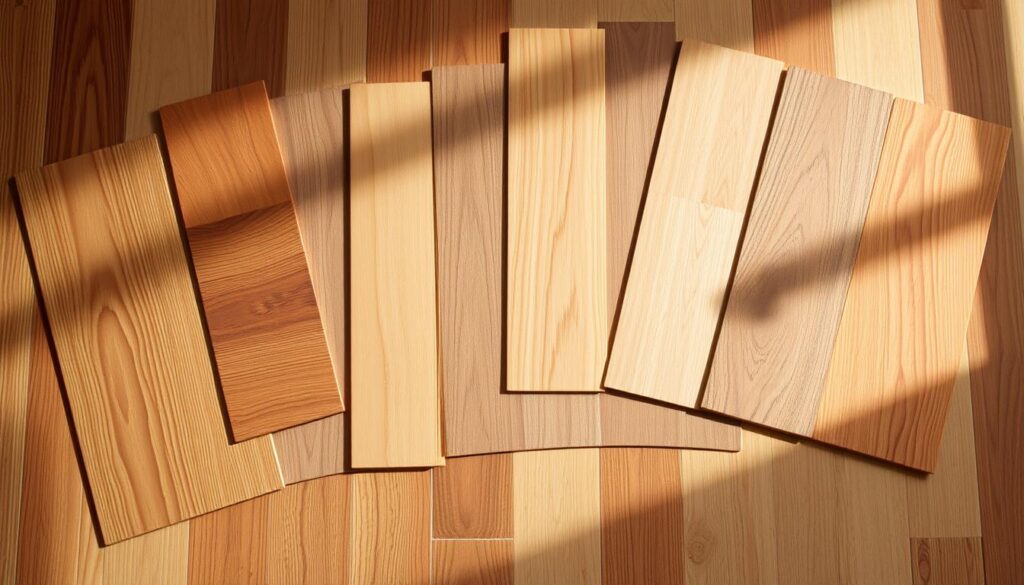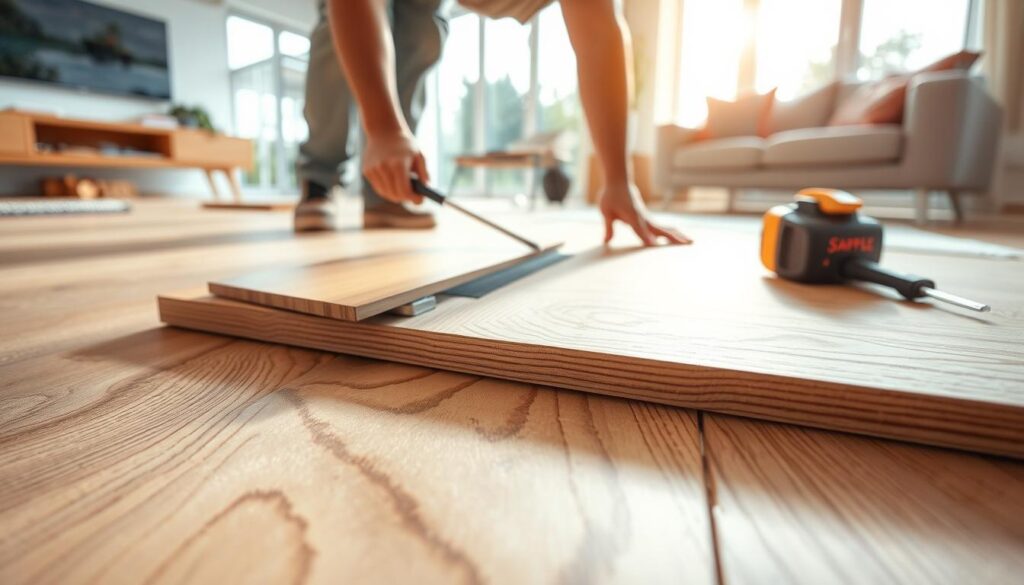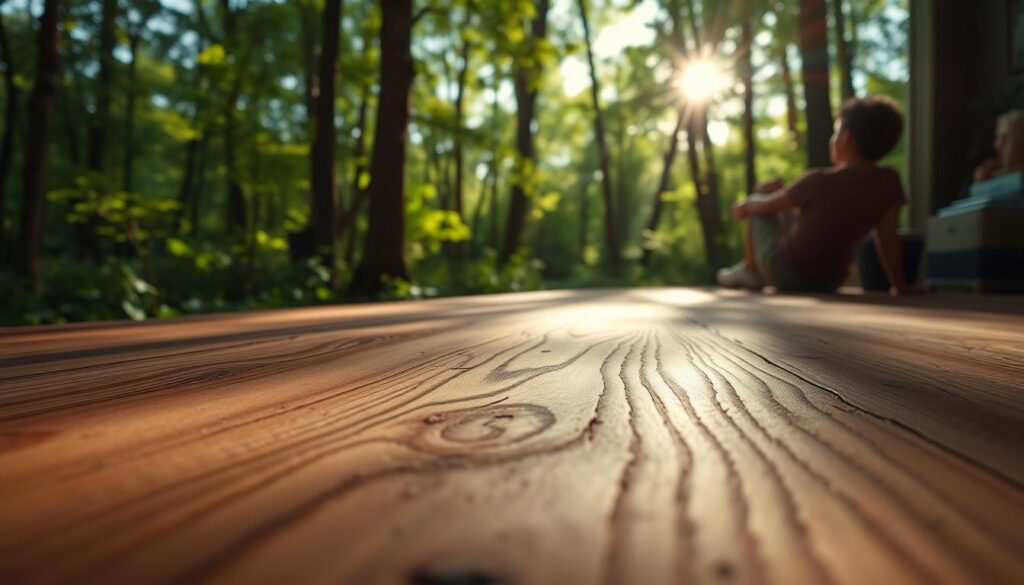Discover how to select the perfect Wood Flooring for your home. Learn about durability, styles, costs, and maintenance to make an informed decision that matches your lifestyle and budget
Finding the right wood flooring for your home can seem hard. But, with the right info, you can pick the perfect fit for your space and budget. This guide will cover the different types of wood flooring. We’ll also look at cost factors, durability, and maintenance needs.

Key Takeaways
- Understand the differences between solid hardwood, engineered wood, and wood-look alternatives like laminate and vinyl.
- Consider the climate and humidity levels in your home, as well as the specific needs of each room.
- Evaluate the durability and maintenance requirements of different wood flooring options to ensure long-lasting performance.
- Explore color and finish options to coordinate with your existing décor and design preferences.
- Weigh the benefits of professional installation versus a DIY approach based on your skills and budget.
Understanding Different Types of Wood Flooring
Choosing the right wood flooring for your home is key. You have many options, from solid hardwood to engineered wood, laminate, and vinyl wood-look flooring. Each type has its own benefits, fitting different needs and tastes.
Solid Hardwood vs. Engineered Wood
Solid hardwood is a timeless favorite for its durability and refinishing ability. Engineered wood, with its real wood top layer, is better for areas with moisture and temperature changes. Think about your home’s conditions, budget, and style when deciding between solid hardwood and engineered wood.
Popular Wood Species for Flooring
- Oak: A timeless and versatile option known for its distinctive grain patterns.
- Maple: Renowned for its smooth, consistent texture and light color palette.
- Hickory: Offering a unique, bold appearance with pronounced knots and variations.
- Walnut: Exuding a rich, warm tone and elegant character.
Laminate and Vinyl Wood-Look Options
Laminate and vinyl wood-look flooring are great for those on a budget. They mimic real wood and work well in moist or busy areas. They’re a smart choice for many homeowners.
“Choosing the right type of wood flooring is essential for creating a cohesive and visually stunning living space.”
Knowing the benefits of each wood flooring type helps you choose wisely. Whether you prefer solid hardwood or the flexibility of engineered wood, laminate, or vinyl, there’s a perfect option for your space.
Factors That Impact Wood Flooring Costs
When planning your home renovation, it’s key to know what affects wood flooring prices. This knowledge helps with budget planning. The costs of wood flooring can change a lot, depending on quality and price.
The type of wood is a big factor in wood flooring prices. Solid hardwood floors are pricier than engineered wood or laminate. Also, the wood species you pick can raise the cost. Exotic hardwoods like Brazilian cherry or African mahogany are more expensive than common woods like oak or maple.
The grade and thickness of the wood flooring also matter. Thicker, higher-grade planks cost more but last longer. For those watching their budget, choosing a lower grade or thinner option might save money without losing too much quality.
| Wood Flooring Type | Average Cost per Square Foot |
|---|---|
| Solid Hardwood | $8 – $15 |
| Engineered Wood | $4 – $10 |
| Laminate | $2 – $6 |
Knowing the cost factors of wood flooring prices helps homeowners make smart choices. They can plan their budget better and meet their long-term needs. Talking to a flooring expert can also offer great advice, helping you find the perfect flooring for your home.
Video source from youtube
“Investing in high-quality, durable wood flooring can be a worthwhile long-term investment for your home, but it’s essential to balance your budget and needs.”
Evaluating Your Home’s Environment and Traffic Patterns
Choosing the right wood flooring for your home is crucial. You need to think about your home’s environment and how much foot traffic it gets. This way, your floors will look great and last long.
Climate and Humidity Considerations
The climate and humidity in your area matter a lot. Wood floors can expand, contract, and warp because of moisture and temperature changes. Pick a moisture-resistant wood and the right installation for your climate. This keeps your floors beautiful and strong for years.
Room-Specific Requirements
- High-traffic spots like entryways and living rooms need durable, scratch-resistant wood.
- Kitchens and bathrooms, with more moisture, are better with engineered wood or moisture-resistant floors.
- Bedrooms and formal areas can handle softer wood since they get less foot traffic.
Foot Traffic Analysis
Look at how much each room is used. Busy rooms need tough, scratch-resistant wood. Less busy rooms can have softer wood. This helps you pick the best flooring for your home.
Think about your home’s environment and foot traffic to choose the best wood flooring. The right choice enhances your home’s beauty and comfort.
For more info or to set up a meeting, call us at +6282332572828 or email info@timbertropics.com.
Wood Flooring Durability and Maintenance Requirements
Choosing the right wood flooring for your home is important. Durability and maintenance are key. Your floors should last long, withstanding daily use and proper care. We’ll look at how to keep your floors in top shape for years.
Scratch-Resistant Flooring Options
Not all wood floors are the same when it comes to scratches. Hardwoods like oak and maple are very durable. Softer woods, like pine, might get scratches and dents more easily. Engineered wood floors, with their strong build and protective layers, also resist scratches well.
Maintaining Wood Floors for Longevity
Keeping your wood floors in good shape is crucial. Regular sweeping, vacuuming, and occasional damp mopping remove dirt. The right cleaners and sealants boost water resistance and floor life.
“Caring for your wood floors is like tending to a garden – with a little diligence, you can enjoy their natural beauty for years to come.”
By picking scratch-resistant flooring and sticking to a care routine, your floors will stay beautiful and strong. For more on our wood flooring and installation, call Timber Tropics at +6282332572828 or email info@timbertropics.com.
Color Selection and Interior Design Coordination
Choosing the right wood floor color and finish is key to blending your new flooring with your home’s design. You can pick from calming neutral tones to striking, bold shades. The wood floor colors you choose greatly affect a room’s look.
Wood Stains and Finishes
Look at a wide range of stain options to find your perfect match. You can go for light, natural finishes that highlight the wood’s beauty or deep, bold hues for a statement look. Think about the room’s lighting, your current decor, and your style to pick the right stain.
The finish of your wood floors, like matte, satin, or glossy, also matters. Matte finishes give a soft, subtle look. Glossy finishes add elegance and shine to your space.
Matching Existing Décor
When picking new wood floors, think about how they’ll match your interior design. Check the colors, textures, and styles of your furniture, walls, and other decor. This ensures a smooth and beautiful look in your home.
By carefully picking your wood floor color and finish, you can make your floors blend well with your home’s design. For help choosing the right wood floors, contact our team at Timber Tropics (Phone: +6282332572828, Email: info@timbertropics.com).
| Wood Stain Color | Décor Style | Ambiance |
|---|---|---|
| Light Oak | Farmhouse, Coastal | Bright, Natural |
| Walnut | Modern, Industrial | Warm, Sophisticated |
| Dark Cherry | Traditional, Transitional | Rich, Elegant |
Installation Methods and Requirements
There are several ways to install wood flooring. The best method depends on your subfloor, the type of flooring, and your DIY skills. Let’s look at the main installation options and what you need for each.
Nail-Down Installation
The traditional nail-down method attaches hardwood planks to a wooden subfloor with special nails or staples. It’s strong and stable, making it a favorite choice. But, you need a solid, level subfloor and some carpentry skills for a smooth install.
Glue-Down Installation
Glue-down installations stick the wood flooring planks to the subfloor with a special adhesive. It’s good for concrete or wood subfloors and offers a strong base. But, you must prepare the subfloor well for the adhesive to work right.
Floating Floor Installation
Floating floor systems don’t need nails or adhesives. The planks just click together, resting on the subfloor. It’s great for DIY projects because it’s easy and forgiving.
Whichever method you pick, making sure the subfloor is ready is key. It should be clean, level, and free of debris or uneven spots. These ensure your flooring stays stable and looks good for a long time.
Talking to a professional flooring installer or doing your homework on your flooring and subfloor is wise. The right steps will make your wood floors beautiful and durable for years.
| Installation Method | Subfloor Requirements | Skill Level |
|---|---|---|
| Nail-Down | Solid, level wooden subfloor | Intermediate to Advanced |
| Glue-Down | Clean, smooth, and flat subfloor (concrete or wood) | Intermediate to Advanced |
| Floating Floor | Relatively flat and clean subfloor | Beginner to Intermediate |
For more info or to book a pro install, call Timber Tropics at +6282332572828 or info@timbertropics.com.

Comparing Wood Flooring Warranties and Guarantees
Wood flooring warranties and guarantees are key to protecting your investment. Knowing the difference between these can help you choose the best flooring warranty, quality assurance, and consumer protection.
Manufacturing Warranties
Manufacturers offer warranties that cover the wood flooring’s structure and performance. These warranties often include:
- Structural defects
- Finish wear and tear
- Moisture-related issues
- Fading or discoloration
It’s important to read the warranty terms carefully. Make sure they meet your expectations and your home’s needs.
Installation Coverage
Wood flooring installation may also have its own guarantee. This covers issues related to how it was installed, like:
- Improper installation techniques
- Subfloor preparation problems
- Warranty-related claims from installation errors
Good flooring retailers and installers offer this warranty. It adds extra protection to your investment.
Understanding the differences between these warranties helps you make a smart choice. Your wood flooring will be protected for many years. For more information or help, contact us at info@timbertropics.com or call +6282332572828.
Sustainable and Eco-Friendly Wood Flooring Options
Homeowners are now choosing eco-friendly wood flooring more often. This is because they want to make environmentally conscious choices. Adding green flooring to your home can make it both beautiful and sustainable.
Sustainably sourced wood is a popular choice. It comes from forests managed well, keeping nature balanced. Look for products with Forest Stewardship Council (FSC) or Sustainable Forestry Initiative (SFI) certifications. These ensure the wood is good for the environment.
Reclaimed wood is another great option. It’s made from old buildings or barns. This choice is unique, adds charm, and helps reduce waste. It’s perfect for those who want a special, eco-friendly flooring that’s also green.

When picking green home flooring, think about its durability and upkeep. Also, consider how it fits your home’s style. Choosing wisely lets you enjoy wood floors while helping the planet.
For more info on eco-friendly flooring, call Timber Tropics at +6282332572828 or email info@timbertropics.com. Our experts can help you find the best sustainably sourced wood flooring for your home.
Professional Installation vs. DIY Considerations
Choosing between professional installation and DIY for wood flooring has its pros and cons. Think about the costs, your skills, and the tools you need. These factors are key to making a decision.
Cost Comparisons
Professional flooring services cost more upfront but offer warranties and guarantees. These can save you money later. DIY installation might seem cheaper at first but requires a big investment in tools and materials.
Skill Requirements
- Professionals have the skills for a perfect, lasting finish.
- DIY needs carpentry skills, patience, and detail for success.
- Mistakes in DIY can be costly and might need a pro fix.
Tool Investments
DIY wood flooring projects need expensive tools like flooring nailers and moisture meters. These tools are crucial for a professional look.
| Considerations | Professional Installation | DIY Installation |
|---|---|---|
| Cost | Higher upfront cost, but potential long-term savings with warranties | Lower initial cost, but requires tool investments |
| Skill Level | Experienced installers ensure a flawless finish | Requires carpentry skills and attention to detail |
| Tool Investments | Included in the service | Significant investment in specialized tools |
The choice between professional installation and DIY depends on your budget, skills, and tool investment. Weigh the pros and cons to decide what’s best for your home.
Conclusion
When choosing wood flooring, it’s key to think about several important factors. You need to know the different types of wood flooring. Also, consider your home’s environment and how much traffic it gets.
Think about how durable and easy to maintain your wood flooring is. Choose a color that fits your home’s style. Look into the installation methods and warranty to make sure it’s a good choice.
If you’re not sure about your choice, get expert advice. Contact Timber Tropics at +6282332572828 or info@timbertropics.com for a consultation. Their team can offer personalized advice to help you pick the right wood flooring for your home.
FAQ
What are the different types of wood flooring available?
You can choose from solid hardwood, engineered wood, laminate, and vinyl wood-look options. Each has its own benefits and best uses.
How do I choose the right wood species for my floors?
Think about durability, grain pattern, and color when picking a wood species. Oak, maple, hickory, and cherry are popular for their looks and performance.
What factors affect the cost of wood flooring?
The cost depends on the wood type, grade, thickness, and installation method. The wood species, finish, and subfloor condition also play a role.
How do I ensure my wood floors are durable and easy to maintain?
Choose wood floors that are scratch and water resistant. Follow the recommended care for your flooring type to keep it looking great.
How do I coordinate my wood flooring with my home’s interior design?
Pick the right wood floor color and finish to enhance your home’s look. Match your new floors with your décor for a beautiful result.
What are the differences between professional installation and DIY wood flooring projects?
Professional installation is often better but costs more. DIY is cheaper but needs skill and tools. Think about the costs and risks before choosing.
What should I look for in wood flooring warranties and guarantees?
Check the manufacturer’s warranty and any installation coverage. Knowing the terms helps protect your investment.
Are there any sustainable or eco-friendly wood flooring options available?
Yes, there are eco-friendly options like sustainably sourced and reclaimed wood. Look for certifications like Forest Stewardship Council (FSC) for environmental standards.
Related article : Buy Red Oak Flooring | Premium Hardwood for Your Home
